-
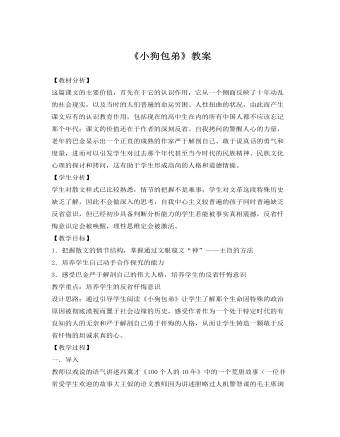
人教版高中语文《小狗包弟》教案
五.课堂总结:巴金是现代中国不多的文学大师、思想家之一,他以丰硕的文学成果以及一生坦荡无瑕圣哲般高贵的人品,向世人证明了爱心的价值、真诚的伟大,以及天才的光芒,这位“20世纪中国的良心”,他的名字必将与鲁迅等人一样,长留青史,像北斗一样在天空闪烁!让我们记住这位老人并学习这位老人的不断进取的精神和严于解剖自己灵魂的勇气,铸造一种坦诚真实的人格。六.课外合作探究:狗与“伤痕文学”巴金此文开篇就写艺术家与狗的故事,然后写自己与狗,不光此篇写狗,他在另外的文章中也写到狗,不光巴金如此,反映文革的“伤痕文学”都经常写到狗,你如何看待这一文学现象?1.学生课外阅读“伤痕文学”查阅相关文学评论(6人一组,4人分组从网上和书籍中查阅相关文章,2人分别查阅相关评论)2.课后教师与学生交流并发表有倾向性的意见:
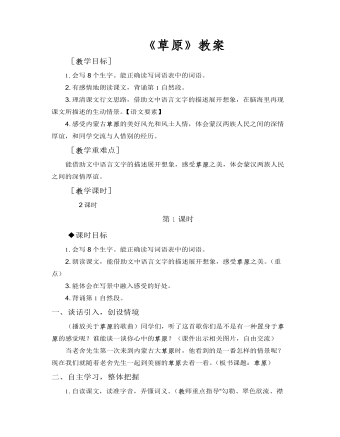
部编版六年级语文上册《草原》教案
1.会写8个生字。能正确读写词语表中的词语。2.朗读课文,能借助文中语言文字的描述展开想象,感受草原之美。(重点)3.能体会在写景中融入感受的好处。4.背诵第1自然段。一、谈话引入,创设情境(播放关于草原的歌曲)同学们,听了这首歌你们是不是有一种置身于草原的感觉呢?谁能谈一谈你心中的草原?(课件出示相关图片,自由交流)当老舍先生第一次来到内蒙古大草原时,他看到的是一番怎样的情景呢?现在我们就随着老舍先生一起到美丽的草原去看一看。(板书课题:草原)

部编版六年级语文上册《草原》教案
(1)思考:作者是按什么顺序写的?写了哪些内容?明确:作者是按事情发展的先后顺序来写的。首先描述了一望无际的草原美景,使人感受到了一种境界美;接着又展示了主人欢迎远方客人的隆重场面;最后把酒话别,用“蒙汉情深何忍别,天涯碧草话斜阳”来收束全文。(板书:初到草原——远迎客人——热情相见——盛情款待——联欢话别)作者笔下的草原给你留下了什么印象?(学生讨论、交流自己的印象,可与读此文之前对草原的印象进行对比并探讨。)
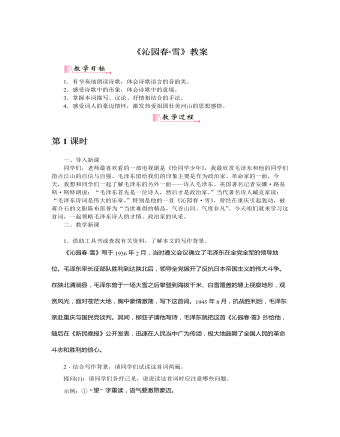
部编版语文九年级上册《沁园春》教案
提问(1):“引”也是个领字,到底“引”出了哪些英雄人物?他们有什么共性?明确:秦始皇、汉武帝、唐太宗、宋太祖、成吉思汗。他们都是中国历史上杰出的人物,是无数英雄中的佼佼者,都是雄才大略、战功赫赫,对中国历史的发展产生过巨大影响的人。提问(2):对于这样杰出的历史人物,词人用一个字对他们做了总的评价,请找出这个字,并说说这个字所包含的感情。明确:“惜”字。包含的感情:第一,惜中含褒。肯定他们是英雄人物,同时也就肯定了中华民族是一个英雄辈出的伟大民族。第二,委婉地批评了他们缺少文治,文学才华欠缺。第三,他们的不足是时代、阶级局限造成的。第四,表现了作者后来者居上的伟大气概。提问(3):作者对秦皇汉武、唐宗宋祖、成吉思汗的评价有区别吗?从哪里可以看出来?明确:有区别,“略输”“稍逊”二词表现作者对秦皇汉武和唐宗宋祖在文治方面的不足只是略有批评,而“只识”一词则表现出对成吉思汗是一种近乎嘲讽的评价。
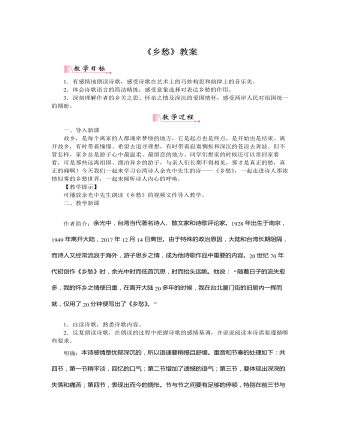
部编版语文九年级上册《乡愁》教案
【教学提示】教师可以示范分析其中两个意象,注意引导学生把握普通事物之所以形成诗歌意象的原因,领悟诗歌意象的内蕴意义。3.诗人在诗中运用了许多表修饰、限制的形容词和数量词,它们有什么特点?它们共同突出了诗歌中四个意象的什么特征?请你简要说说它们在诗歌中的表达效果。明确:“一枚”“一张”“一方”“一湾”四个数量词和“小小的”“窄窄的”“矮矮的”“浅浅的”四个形容词,都是面积小重量轻的词语。然而,邮票虽小,却承载了母子深情;船票虽窄,却联系着夫妻之间浓浓的恋情;矮矮的坟墓,盛不下生死离情之痛;海峡虽浅,隔断的思乡哀愁却是如此之深。这一系列限定修饰词,都反衬了乡愁的浓郁。目标导学四:把握诗歌艺术特征探究:本诗除了在意象选取上颇费心思,在结构艺术上也见出笔力。请同学们说说,本诗还具有哪些令你欣赏的艺术特征。
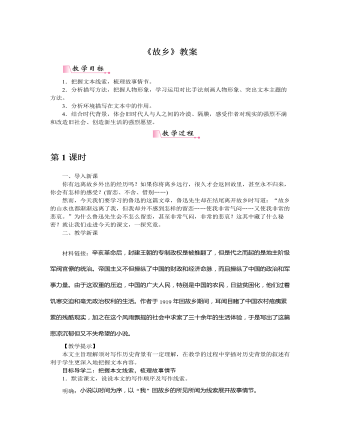
部编版语文九年级上册《故乡》教案
【分析杨二嫂形象】1.昔日的杨二嫂是怎样的一个形象?明确:昔日被称作“豆腐西施”,“擦着白粉”“终日坐着”,是一个安分守己的妇女形象。2.如今的杨二嫂是怎样的形象?作者是从哪些方面刻画的?明确:“凸颧骨”“薄嘴唇”“圆规”等肖像描写,“尖利的怪声”“大叫”“两手搭在髀间”“贵人眼高”等动作和语言描写,表现出了杨二嫂泼悍、放肆、尖刻的性格特征。讨东西、造谣、塞手套又表现出她的自私、泼悍、爱贪小便宜。探究:作者塑造杨二嫂这一形象有什么作用?杨二嫂的形象是作者“悲哀”的源头吗?明确:杨二嫂的变化说明了辛亥革命后,城镇小市民阶层的贫困化,反映了当时社会经济破产的广度和深度。杨二嫂的变化,是不合理制度下的人性转变,如果说闰土是“精神麻木”的状态让作者觉得“悲哀”,那么杨二嫂便是因为失去真善美的人性而使作者觉得“悲哀”。
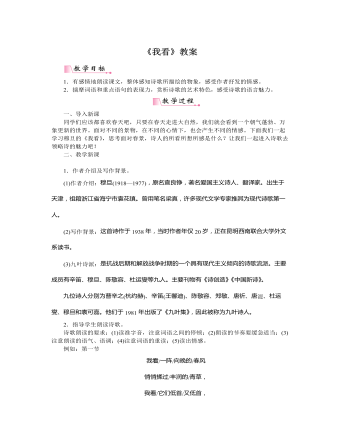
部编版语文九年级上册《我看》教案
目标导学二:再读课文,理解诗意1.品读第一节,思考:第一节包含的意象有哪些?表现了春天大自然的哪些特点?明确:春风、青草。表现了大自然的勃勃生机和美丽生动。2.画出第一节中能表现春风和春草特点的词语,分析它们的表达效果。(可用“以什么修辞或者表现手法表现了什么事物什么特点”的格式来表达)明确:“揉过”“低首”运用拟人的修辞手法,写出了春风吹过草地,小草随风摇曳的情景。“也许远水荡起了一片绿潮”运用比喻的修辞手法,把草地比作“绿潮”,写出了绿草像“潮水”一样涌动,给人带来无限生机和活力。3.品读第二节,思考:第二节紧承第一节哪个词语?第二节描写的意象有哪些?描绘了一幅怎样的画面?明确:紧承第一节的“向晚”。意象:展翅的飞鸟、天边的流云和大地。画面:在黄昏时分,鸟儿在深邃的天空中翱翔,夕阳染红了天边的流云,彩霞铺满天空,也映红了大地。
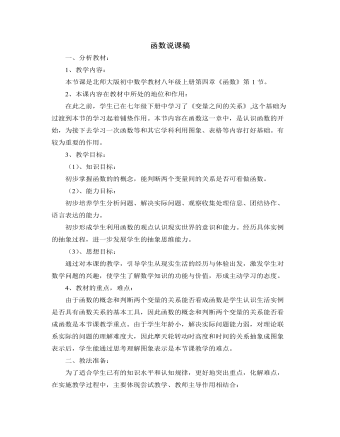
北师大版初中八年级数学上册函数说课稿
然后能通过图象找出变量的对应关系在图象上的体现。3、做一做:课本P154第1小题,学生在课本上填表,让学生通过填表,体会变量之间的相依关系。4、师生小结:和学生一起对刚才的三个例子进行总结,启发学生思考三个例子的相同点和不同点,如表现形式不同,有图象、表格、代数表达式。相同的有它们都是两个变量,确定其中一个变量后就能相应确定另一个变量的值。从而使学生的认识上升一个高度,并掌握函数的概念5、课堂练习:完成课本P155随堂练习。通过本练习的完成巩固概念并会用概念去判断两个变量间的关系是否可看做函数。6、新课巩固:以填空形式对本堂课进行小结,使学生对函数的概念及应用有一定记忆。并通过对最后问题的思考使学生意识到数学来自生活,并能应用于生活。
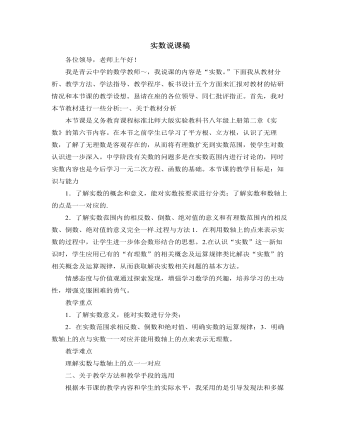
北师大版初中八年级数学上册实数说课稿
接下来学生类比有理数中相关概念,体会到了实数范围内的相反数、倒数、绝对值的意义,并进一步掌握了实数的相反数、倒数、绝对值等知识。学生类比有理数中相关运算,体会到了实数范围内的运算及运算律。并探讨用数轴上的点来表示实数,将数和图形联系在一起,让学生进一步领会数形结合的思想,利用数轴也可以直观地比较两个实数的大小。然后通过相关练习,检测学生对实数相关知识的掌握情况。最后学生交流,互相补充,完成本节知识的梳理。布置作业:所布置作业都是紧紧围绕着“实数”的概念及运用。设计选作题是为了给学有余力的学生留出自由发展的空间。五、关于板书设计我将板书设计为“提纲式”。这样设计主要是力求重点突出,能加深学生对重点知识的理解和掌握,便于记忆。
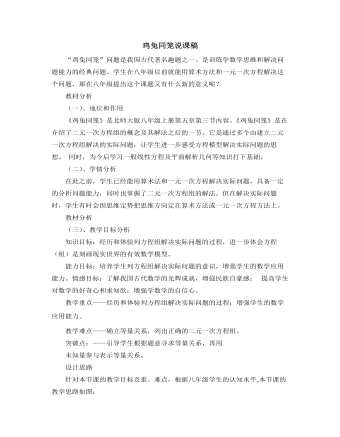
北师大版初中八年级数学上册鸡兔同笼说课稿
三、关于课本素材的处理课本素材:“鸡兔同笼”和“以绳测井”两个古代趣味问题。考虑到八年级学生独立思考和探索问题的能力都已达到一定的水平,特别增加了“自主探索,分层推进”这一环节,为每一位学生都提供了发展的空间。同时师生之间、学生之间共同研讨,形成教与学的和谐统一。凡能列二元一次方程组解决的问题,一般都可列一元一次方程来解,这就影响了用方程组去分析和解决问题,使学生形成思维定势。为此通过对“鸡兔同笼”多种求解方法的分析,使学生经历知识的发生过程,认识到列方程组的必要性和优越性,从而解决学生的思维定势的束缚。 以上是我对《鸡兔同笼》这一节课的一点思考,希望各位专家和老师指正,最后,我用布鲁克菲尔德的一句话来结束我的发言:让学生学会讨论、合作交流,讨论会使学生成为知识的共同创造者!

人教版高中英语必修3Festivals around the World说课稿3篇
Teaching plan for Unit 1 book3Good morning, teachers. It’s my great pleasure to be here because I can share my lesson with you and I can learn a lot from it. I’ll begin my lesson from the following four parts, the teaching material, the teaching methods, the studying methods and the teaching procedure.Firstly, let me talk about the teaching material. The content of my lesson is the reading passage festivals and celebrations of Unit 1 Festivals around the world. This passage is about festivals and celebrations. By studying this passage, we’ll enable the students to know that festivals exit everywhere, and many of festivals in different countries celebrate similar ideas. As we all know, the reading passage is the center of each unit. If the Ss can learn it well, it will be helpful to make the Ss learn the rest of this unit.After studying the teaching material, I think the teaching aims are as the followings:1. Knowledge aims:(1) The Ss can master the usage of the important words andexpressions.(2)The Ss can use the __________________ (grammar) in the proper situation.Make students know about the festivals all over the world and the detail of the festivals, such as origin, content, and the date of the holiday festivals.2. Ability aims:(1) Students can talk about festivals and celebrations in English(2) To improve the student’s reading ability, especially their skimming and scanning ability.3. Emotion aims:Make the Ss know about the foreign festivals, and respect other countries’ custom.Next, let’s come to the important points and the difficult points.The important point is how to make the Ss understand the text better and the difficult point is how can they talk about it. secondly, Teaching Methods:1. task-based Language Teaching2. Computer assisted language teaching.3. question-and–answer methodThirdly, Studying Methods:

人教版高中英语必修4Working The Land说课稿3篇
Knowledge objectives:(1) to make Ss grasp the usage of words, expressions and sentence structures: statistics, struggle, thanks to, rid of, some patterns for persuasion, the “ing” form as subject and object;(2)to use learnt knowledge to persuade sb.Ability objectives:(1) to develop Ss’ reading skills(skimming, scanning, word guessing);(2) to improve Ss’ speaking, communicating and cooperating skills.Emotional objectives:to make Ss know the contribution of Yuan,and learn his spirit and his simple life time.Teaching important and difficult points:(1) some words, expressions and sentence structures mentioned above;(2)the content of the text;(3)training their reading and speaking skills.Teaching methods: CLT, TBLT,QT.Learning strategies: CLS, QLS, TBLS.Teaching procedures:Step 1 lead-in: (1) teacher plays a piece of recent news from CCTV about the harvest of the super hybrid rice, and ask students whether they know Yuan or not, and talk about him and his contribution.(2)Brain storm: let Ss describe Yuan in their minds including his appearance, his living condition and so on.Step 2 fast reading tasks:(1)teacher introduces Yuan and super hybrid rice(2)make Ss read the text as fast as possible with questions. Such as: what’s the general ideaof this passage? What’s Yuan’ dream? (skimming and scanning skill)Step 3 intensive reading tasks(1)let Ss read the text silently, find topic sentence of each paragraph and draw the difficult sentences and the knowledge what they don’t understand.(words guessing)(2)teacher and Ss talk about the important words, expressions and sentences together, and ask Ss to retell the content of the text.(summarizing and paraphrasing)(3)teacher summarize this part.(4) read again following the courseware.

人教版高中英语必修5The United Kingdom说课稿4篇
Teaching Aims:Knowledge 1. Get the students to learn the useful new words and expressions in this section. Aims:2. Let the students learn about how the UK was formed and the four groups of invaders.1. Develop students’ reading ability and let them learn different Ability reading skills. Aims:2. Enable students to learn to talk about the United Kingdom and the Union Jack Emotional 1. Let students know more about the UK2. Develop students’ sense of cooperative learning Aims:Teaching Important Points:1. Let the students learn about the countries of the United Kingdom and the Union Jack2. Get the students to read the passage and know about how the UK was formed and the four groups of invaders.3. Have the students learn different reading skills.Teaching Difficult Ponts:1. Develop students’ reading ability.2. Enable students to talk about the United Kingdom and the Union Jack.3. Let students learn how the UK was formed geographically and historically.Teaching Methods:Showing pictures, asking, exercising, listening, reading etc.Teaching Aids:A computer,a projector and a blackboard.Teaching Procedures: 1) Show a map of the world, ask students the following questions:Where is the UK?What’s the full name of the UK?2) Ask the students work in pairs to do the quiz on Page 9.Do you want to test how many things you know about the United Kingdom? Let’s have a small test.Using the map on P9, students answer the following questions:?How many countries does the UK consist of? What are they??England is divided into three main areas. Do you know what they are? 1) Scanning (10Minutes )Let the students hold the questions asked in pre-reading and read the passagequickly and then let them do the following exercise.Join lines to the right answer.

人教版高中英语必修1Journey Down the Mekong说课稿
2. let the Ss complete the forms paragraph by paragraph. Purpose here is to help Ss to get the habit of reading a passage as a whole, and pay attention to the organization of the text, as a result the Ss will fully understand the whole passage.3. ask Ss to retell the passage with the help of the key words in the form.Since the Ss in the class are in different levels, so I let them to fill in the blank to understand the meaning of the words and phrases better. ( That’s all for the while-reading. Now let’s move to the fifth step.)Step V: Post-reading (10mins) ---DiscussionIn this part students are asked to discuss in groups and list Wang Kun’s and Wang Wei’s attitudes about the trip. After that, Ss are encouraged to express their attitudes with the whole class. Collect their answers and don’t forget to praise them even if their answers may not be perfect.In this activity, discussion provides a vivid and active learning environment for Ss to communicate in English with newly learned language items. (Finally it comes to the homework.)StepⅥ: Homework (1min)1. Ss are required to read the text again after class and figure out the meaning of some complex sentences.2. Do the exercises on P19; This can help Ss to consolidate what they’ve learnt and make preparation for the next lessonPart4. Blackboard design.(说板书设计)On the top, there is the title of this lesson. On the left, there are main ideas for each paragraph. On the right, there are some new words and expressions.Unit 3 Travel journalJourney down the MekongMain idea of each para.:Para1: deciding to take a great bike trip along the Mekong river.Para2: Different attitudes between Wang kun and Wang wei.

人教版高中英语必修1English around the world说课稿
(3)v. 给:提出;展现,显现present sb. with sth. ; present sth. to sb. 把. . 交给;颁发;授予present sth. (for sth. )/present sth. to sb. e. g. Om his birthday, his friends presented him a collection of stamps. 在他生日时,他的朋友们送给他一套邮票作为礼物。The sword was presented by the family to the museum. 这家人把宝剑捐赠给了博物馆。The committee will present the final report to Parliament in June. 委员会将在六月向议会提交最后的报告。You need to present yourself better. 你需要更善于展现自己。It is essential that we present a united front. 至关重要的是我们要表现得更加团结。Step 4 ConsolidationT:Now that we have got a general idea of these words and phrases. Lets make up some sentences using them to master them. Suggested sentences:1. Your duties include typing letters and answering the telephone. 2. It is one of the greatest roles that she has played. 3. A large number of people have applied for the job. 4. The number of the panda is declining. 5. I'11 go there, even if I have to walk. 6. He came up to me to ask for a light. 7. The novel is about a family who can't communicate with each other. 8. He based his plan on interests of most people. 9. Why doesn't he make use of his singing talent?Step 5 Summary and homeworkT:Today we dealt with several new words and phrases. After class I hope that youcan read them again and again to keep them in mind. That's all for today. You aredismissed.

人教版高中英语必修2The Olympic Games说课稿2篇
Purpose of my design:To ask the students to do these two tasks will make the Ss predict the story of this passage. As a result, it will deepen Ss’ memory of this story because they will have their own understanding of this story.Step 3. While-readingTask 1. (Individual work _____min)Skimming: ask students to skim the text and the main ideas of each paragraph in this passage. Please read it quickly and then match the sentences with the letters.Task 2. (Individual work _____min)Scanning: read the text quickly and decide the whether the following statements are true or false and give reasons.Task 3. (Pair work _____min)Listen to the tape and fill in the banks. Then read the paragraph with expression to your partner.Task4 (individual work min)Listen to the tape again and write down the main idea in one sentence.Purpose of my design: Enable students to understand the given material better by using different reading skills. And proper competition can arouse the Ss’ interest in English learning. “Task-based” teaching method is used here todevelop the Ss’ ability of communication and also their ability of co-operation will be well trainedStep 4. Post-readingTask 1. (Individual work, pair work, group work, class work; _____min)Discussion (group of 4):1. If you were Hippomenes, would you run against Atlanta?2. Do you think Hippomenes deserved to win the race? Why or why not?Step 5. HomeworkPlease read the story again carefully after class and imagine: What will happen during the race between Hippomenes and Atlanta? Who do you think will win the race? Do you think Atlanta would marry Hippomenes? Write an end for the story with thses questions.Purpose of my design: Homework is so important and necessary for to master the knowledge they learned after class. It will check whether the Ss achieve the teaching aims.Part 5 Blackboard design

人教版高中英语必修3Canada-the true north说课稿4篇
Good afternoon, teachers, It’s my great pleasure to be here sharing my lesson with you.The content of my lesson is Senior English Book 3 Unit 5 Canada —— “The true North”.I’ll be ready to begin this lesson from five parts. Analysis of the teaching material,the teaching methods,the studying methods, the teaching procedure,and Blackboard design.First, let me talk about the teaching material.Part 1 Teaching Material:This unit is about the introduction of Canada. By studying of this unit,we’ll enable the students to learn the geography, population, main cities, and natural beauty, natural resources of Canada. Through the training of the unit, it also requires students to learn some Language skills such as the expressions of position and emotions.So it plays an important part in the English teaching in this book.After studying the teaching material and analyzing the rule of children’s growing of mind,I think the teaching aims are the followings:1.Knowledge objects:(1) make the students learn some new words and phrases(2) make the students understand the content of the lesson.2.Ability objects:(1)To develop the Ss’ abilities of listening, speaking, reading and writing. Especially reading and speaking ability.(2) learn to talk about the characters of Canada in English(3)To train the Ss’ ability of working in pairs.3.Emotion objects:(1)Enable students to understand the characters of Canada..(2)Stimulate Ss to work hard to make China stronger.Part 2 Teaching Methods:I think helping students learn to master new words and phrases and improve the students’ reading and speaking ability is import and the difficult.According to the analysis of the teaching material and the import points and the difficult points,I will use the following teaching methods : question-guiding approach; fast-reading and careful reading; multi-media teaching methods; discussion

人教版高中英语必修5Life in the Future说课稿5篇
Good afternoon, everyone. It’s my great pleasure to be here sharing my lesson with you. The content of my lesson is Senior English for China Book5 Unit 3 Life in the Future. I’ll be ready to begin this lesson from six parts: Analysis of the teaching material, Analysis of the students, Teaching aims and important and difficult points, Teaching methods and aids, Teaching procedures, and Blackboard design. First, let me talk about the teaching material.Part 1 Analysis of the Teaching Material:This unit is about what human beings’ life will be like in about one thousand years. By studying of this unit, we’ll Enable the students to know the changes in humans’ life and some new inventions bringing about the change and develop the interest in science. This lesson plays an important part in the English teaching in this unit. This is an important lesson in Book Five. From this lesson, it starts asking the Ss to grasp contents of each passage. Therefore, this lesson is in the important position of the teaching material. If the Ss can learn it well, it will be helpful to make the Ss learn the rest of this unit.Part 2 Analysis of the SsAs Senior2 Ss, they are at different levels of English fluency, some of them have lost interest in English. So during the lesson, I arrange a variety of activities to let all of them join in to attract their interest and let them be confident and taste the joy of success.

人教版高中英语必修5Making the news说课稿4篇
今天我们来介绍一下必修五第四单元的授课方式。这个单元的题目是Making the news。应该是学生比较感兴趣的话题,学生往往对新闻工作充满好奇,所以我们可以利用这个机会多设计一些师生互动和学生互动,来激发起学习的积极性,提高学习效率。同时我们可以利用这个单元不仅帮助学生掌握语言知识,培养语言能力,同时让其了解新闻工作的重要性,培养起社会智能感。这个单元分为六个课时,它的教学目标是这样的:语言目标是掌握词汇表中的常用单词和短语,掌握倒装句的一些基本用法。 技能目标是能初步掌握约会的基本句型并在真实的场景下正确运用。新闻报道类文章的写作技能。采访的基本规范和沟通技能。情感目标是对新闻报道的客观性和真实性有更好的理解。对新闻记者的职业有更深入的了解,并能体会其工作的重要性。下面我们来介绍一下第一课时的授课方式,第一课的教学目标是这样的第一课时的教学目标语言目标:单词:Occupation, journalist, editor, photographer, curious, personality, enthusiasm

人教版高中英语必修3The million pound bank note说课稿3篇
在接下来的细读环节,我套用了高考对阅读理解的考查方式设置了5个问题,分别为三个推理判断题,一个细节题和一个主旨大意题。学生需要对文章的内容进行分析、归纳、推理、猜测等高级思维活动才能做出正确的回答。【设计意图】这一过程是对学生进行细读的训练,培养学生获取特定信息和挖掘文章深层次信息的能力。第三环节:Intensive-reading (精读) 15′第三个环节精读,既是最重要的环节,也是突破本课重难点的关键。首先,让学生思考剧本中人物看到百万英镑前后的态度发生了怎样的变化。其次,让学生仔细阅读文章,找出可以表现人物态度变化的具体的语言和动作。最后,让学生总结人物的态度发生变化的根本原因是什么,从而引出Money Talks, 供学生思考。【设计意图】通过一系列的活动培养学生学习从人物的语言和动作探究人物的心理,使学生进一步体会戏剧语言的魅力,从而对文章背后所反映的社会问题进行思考,也为下一步的讨论环节做好铺垫。

